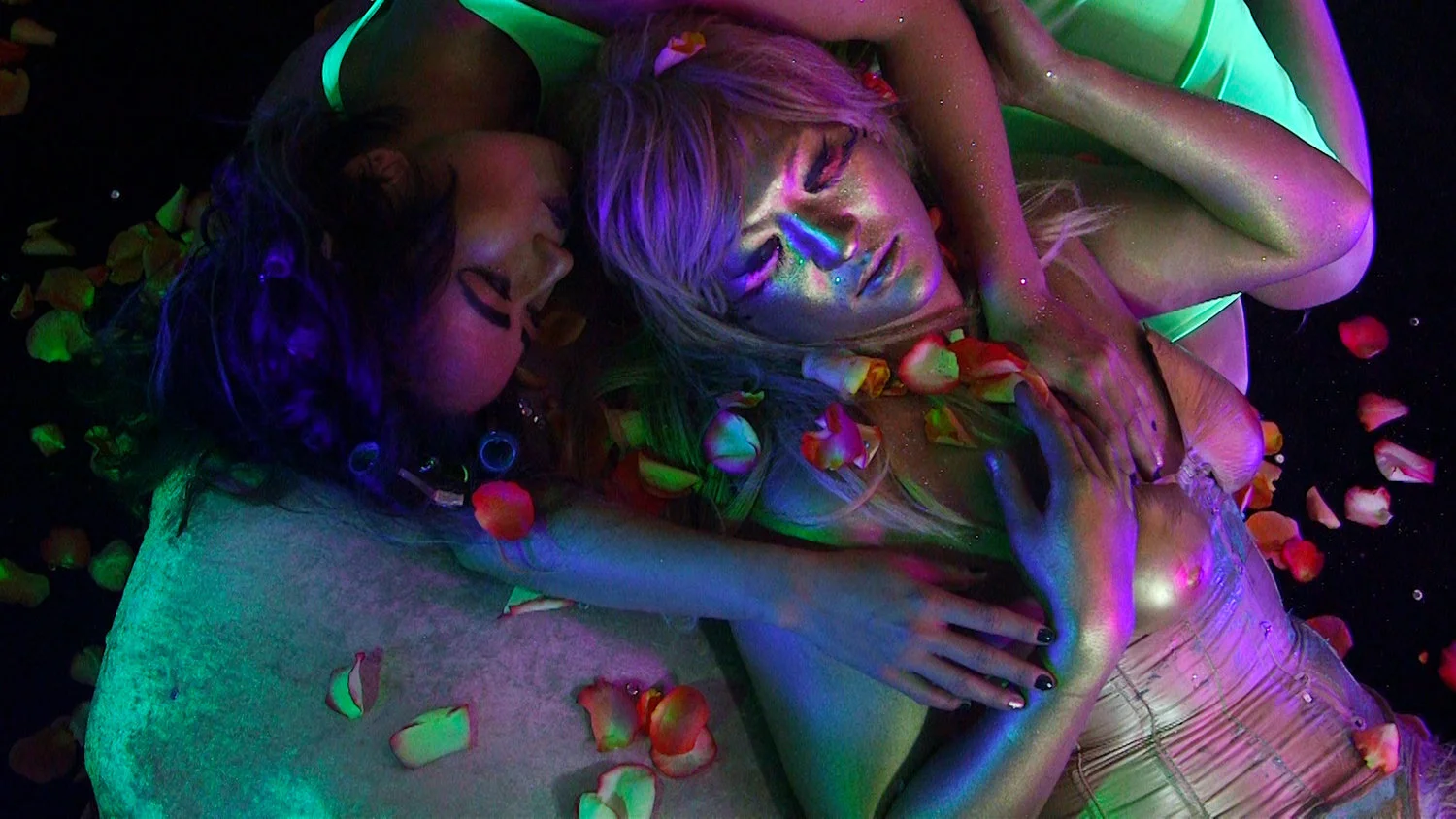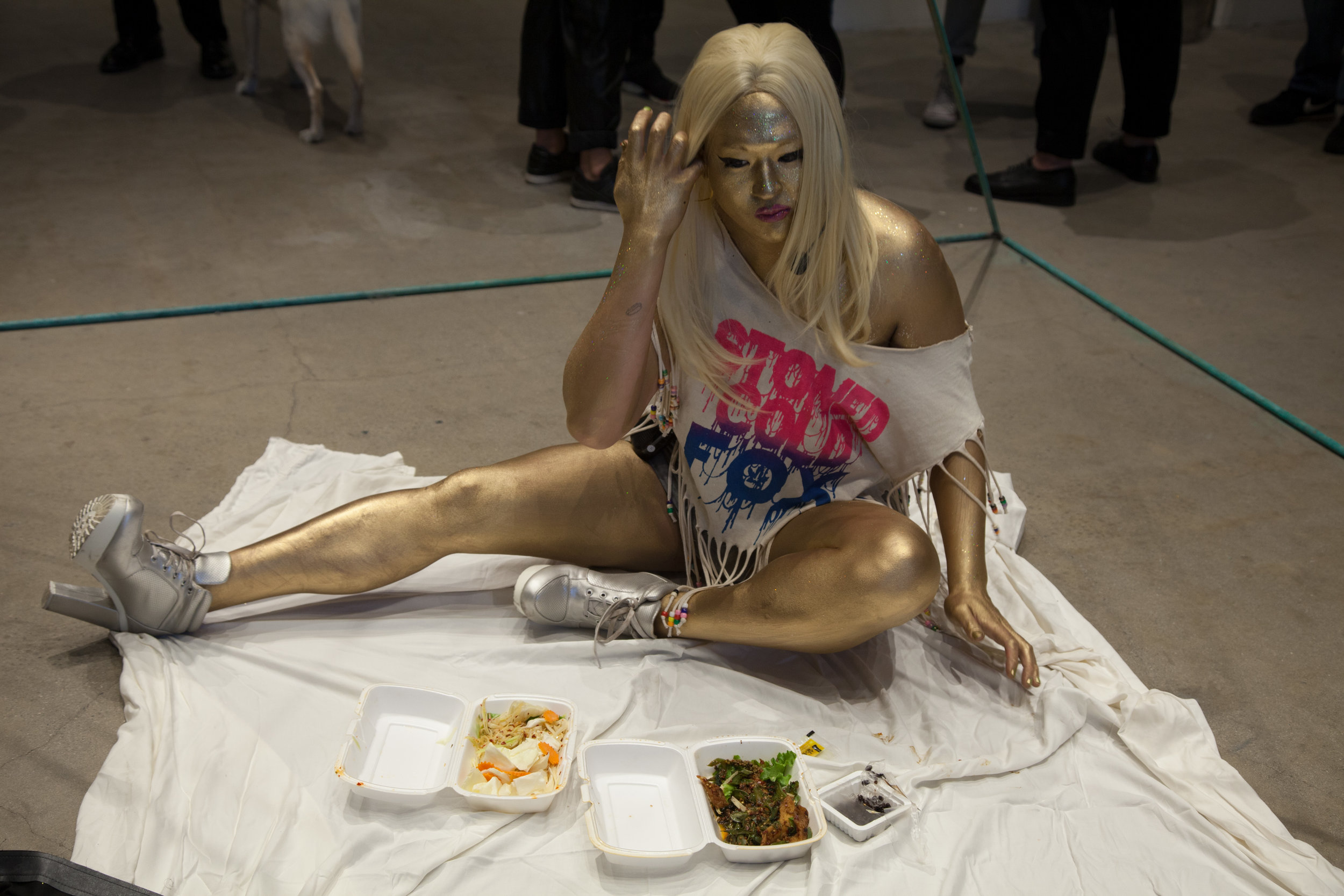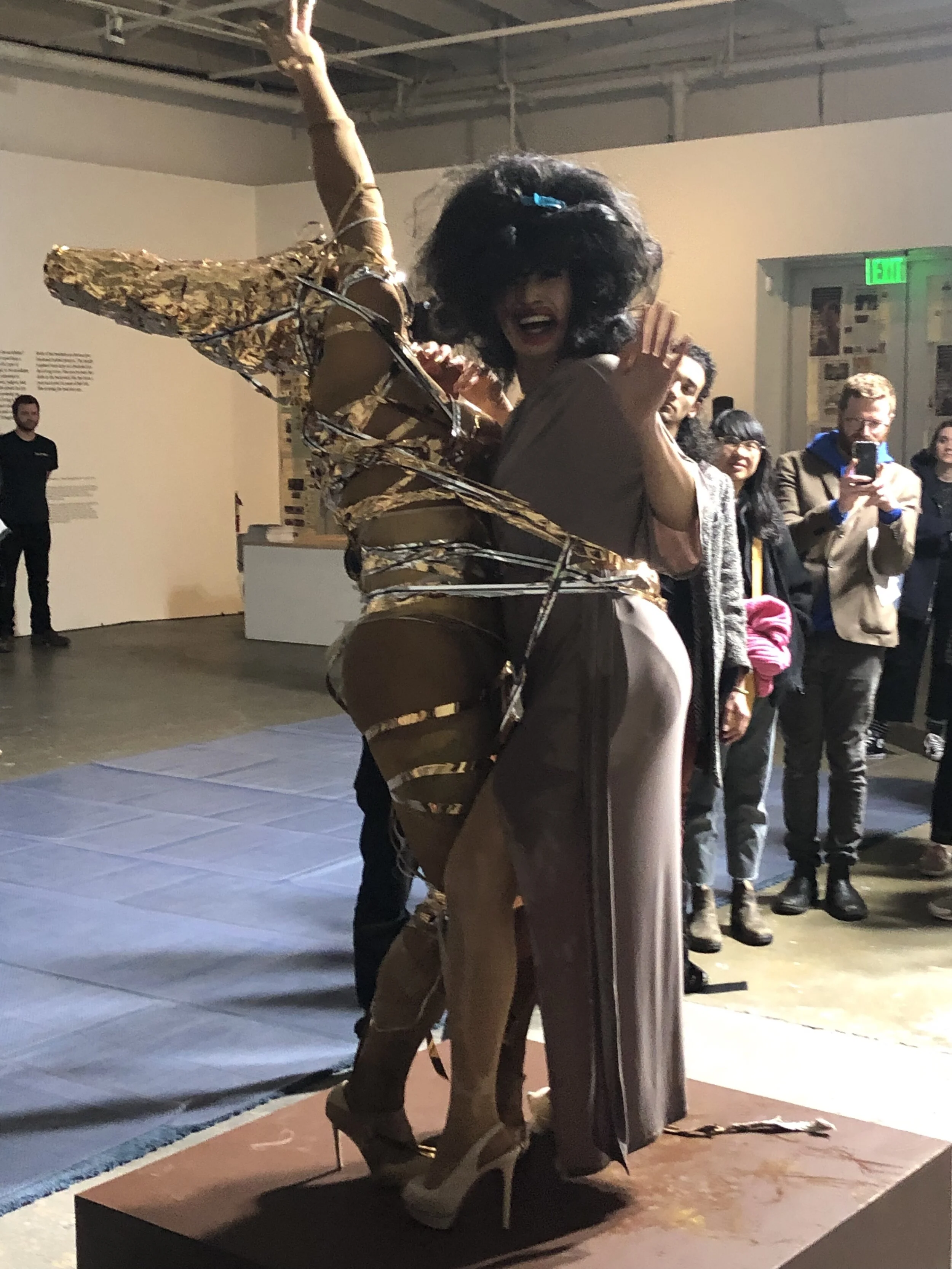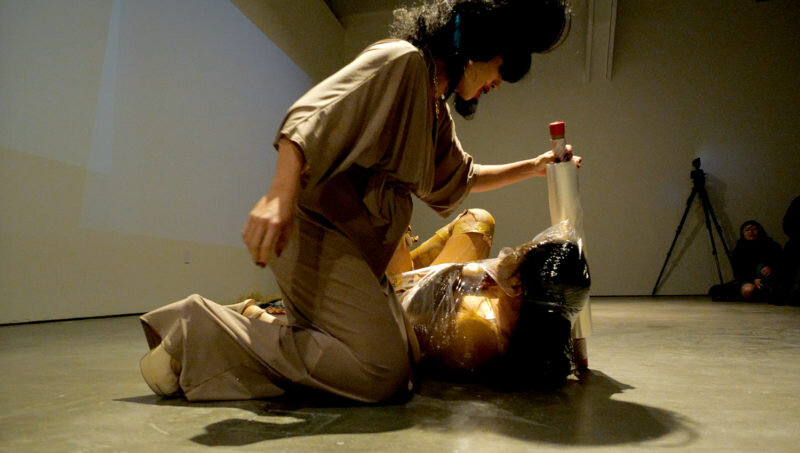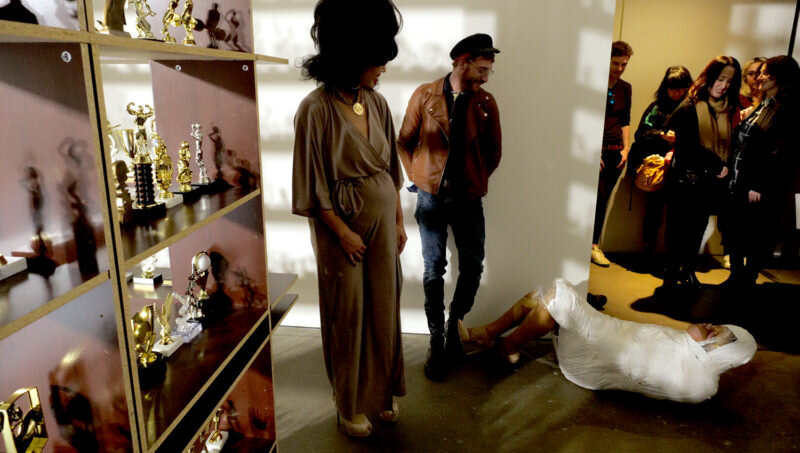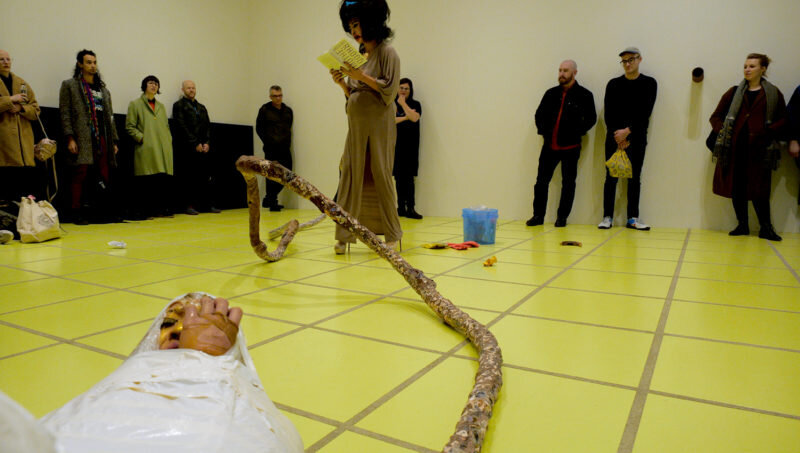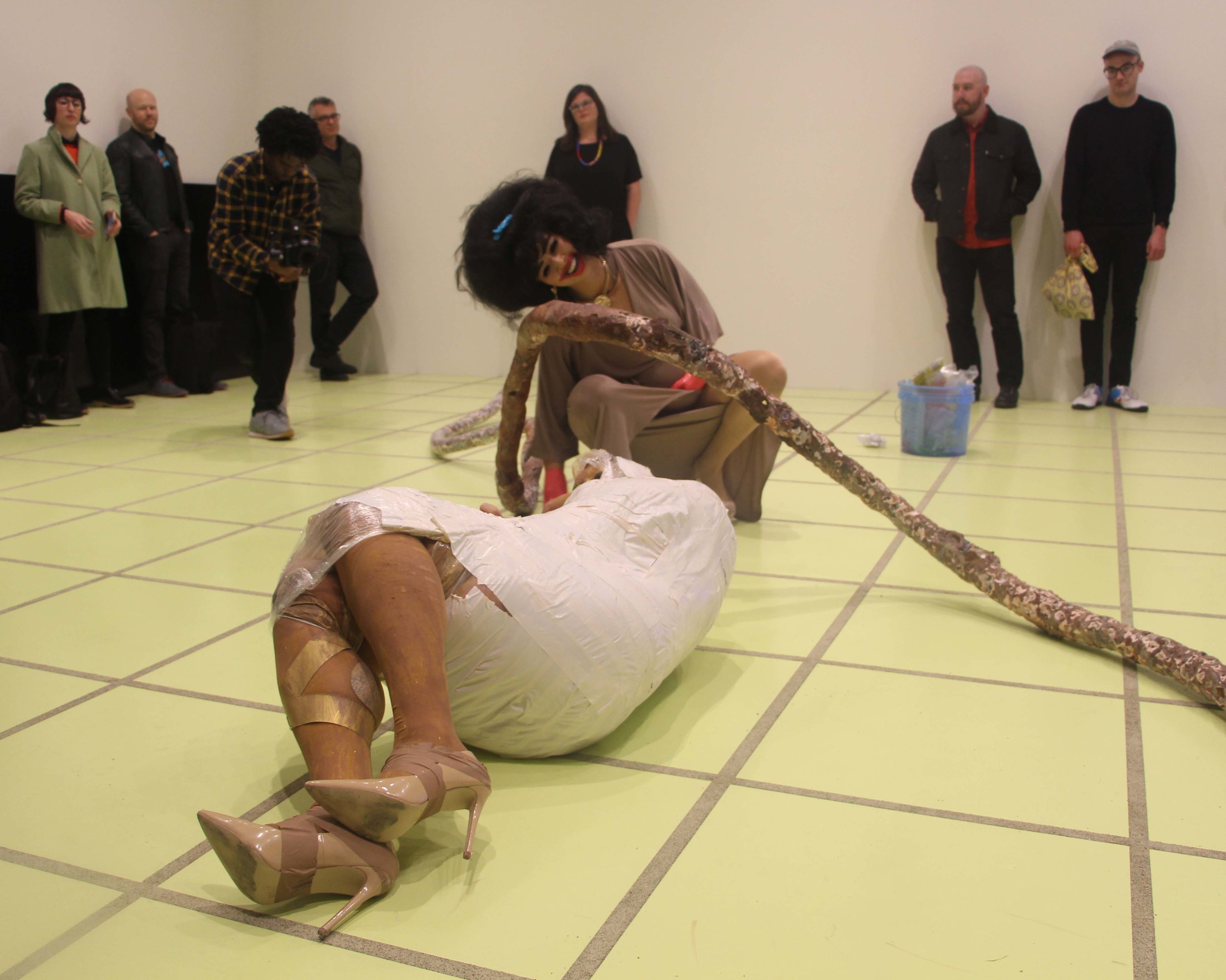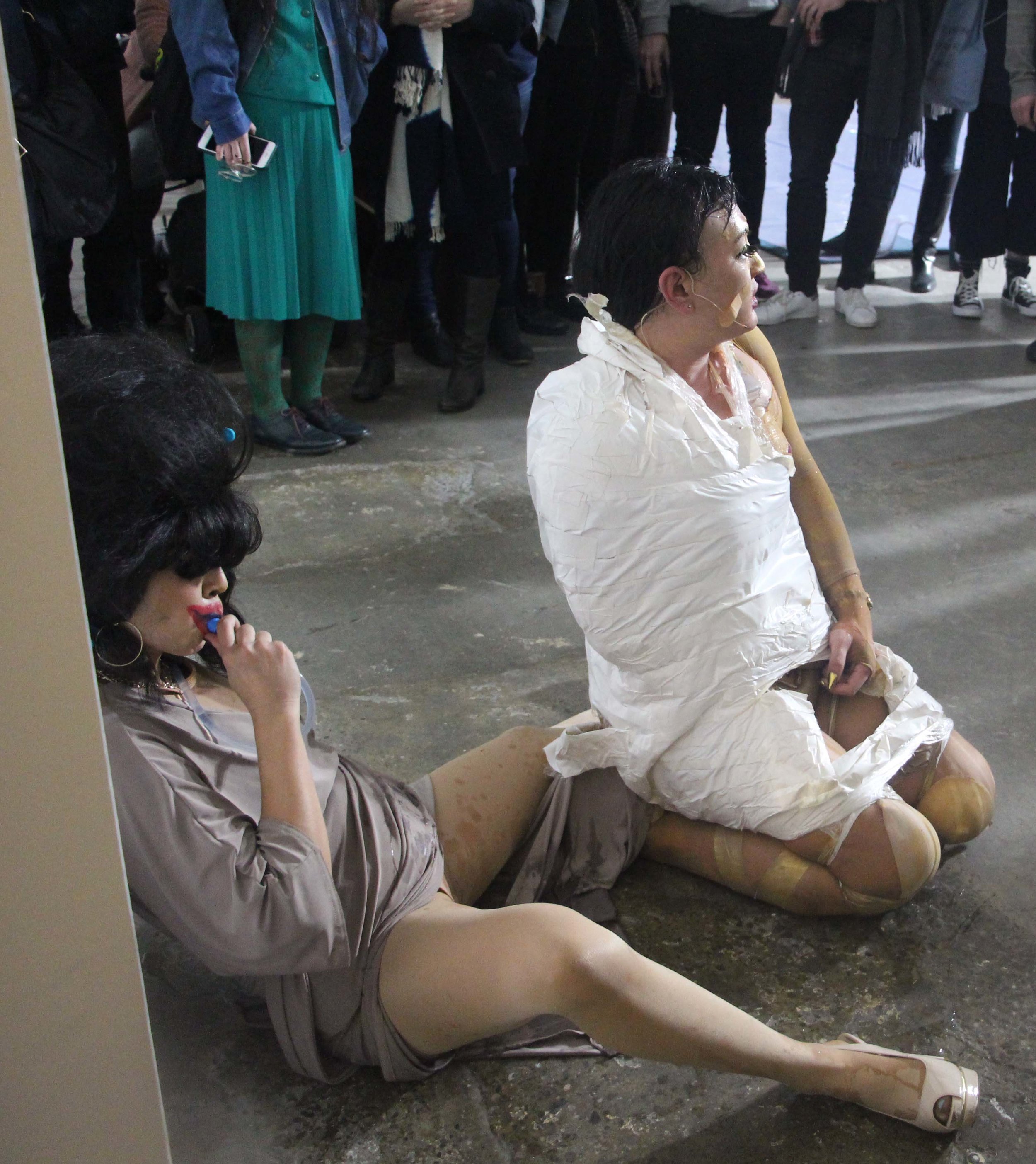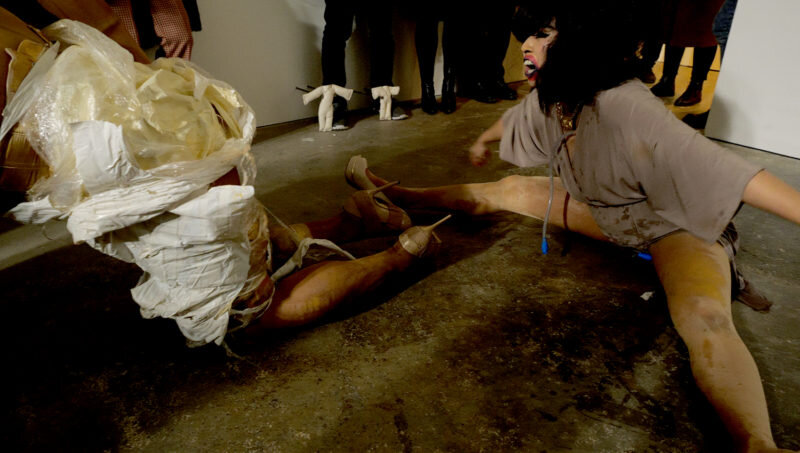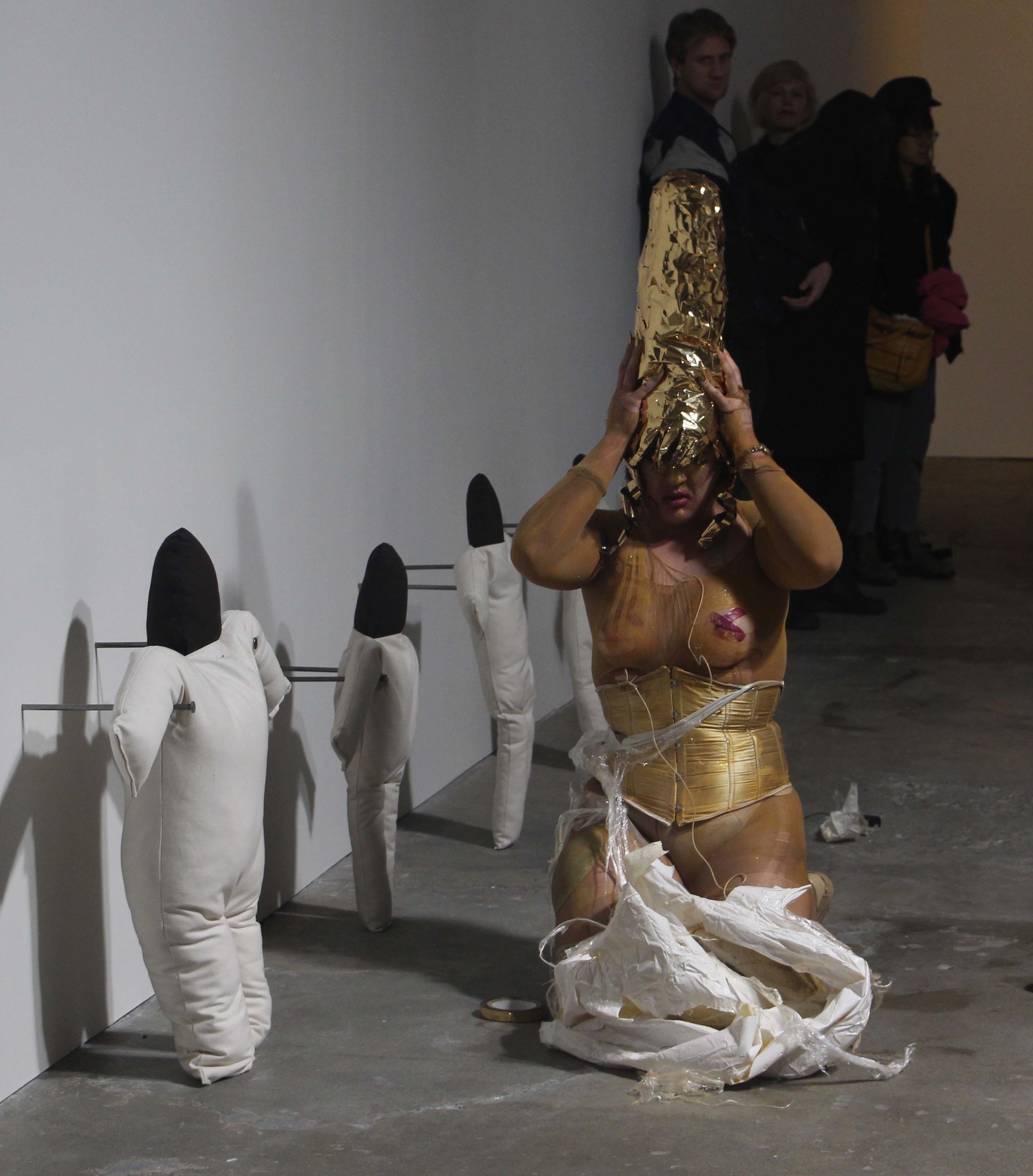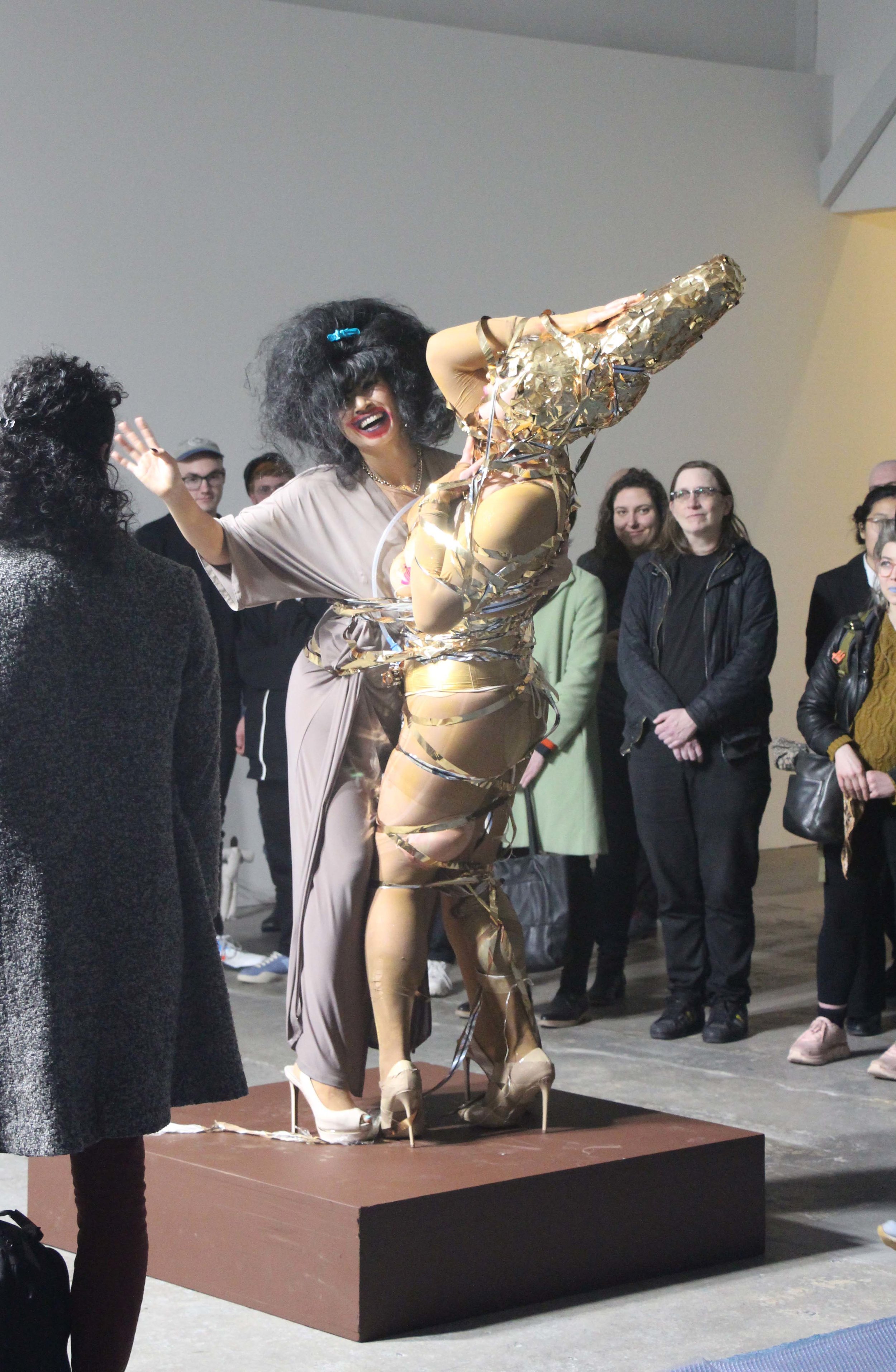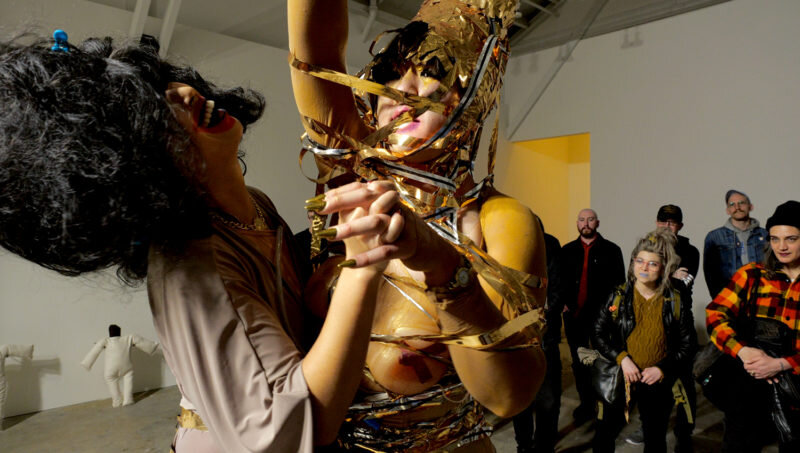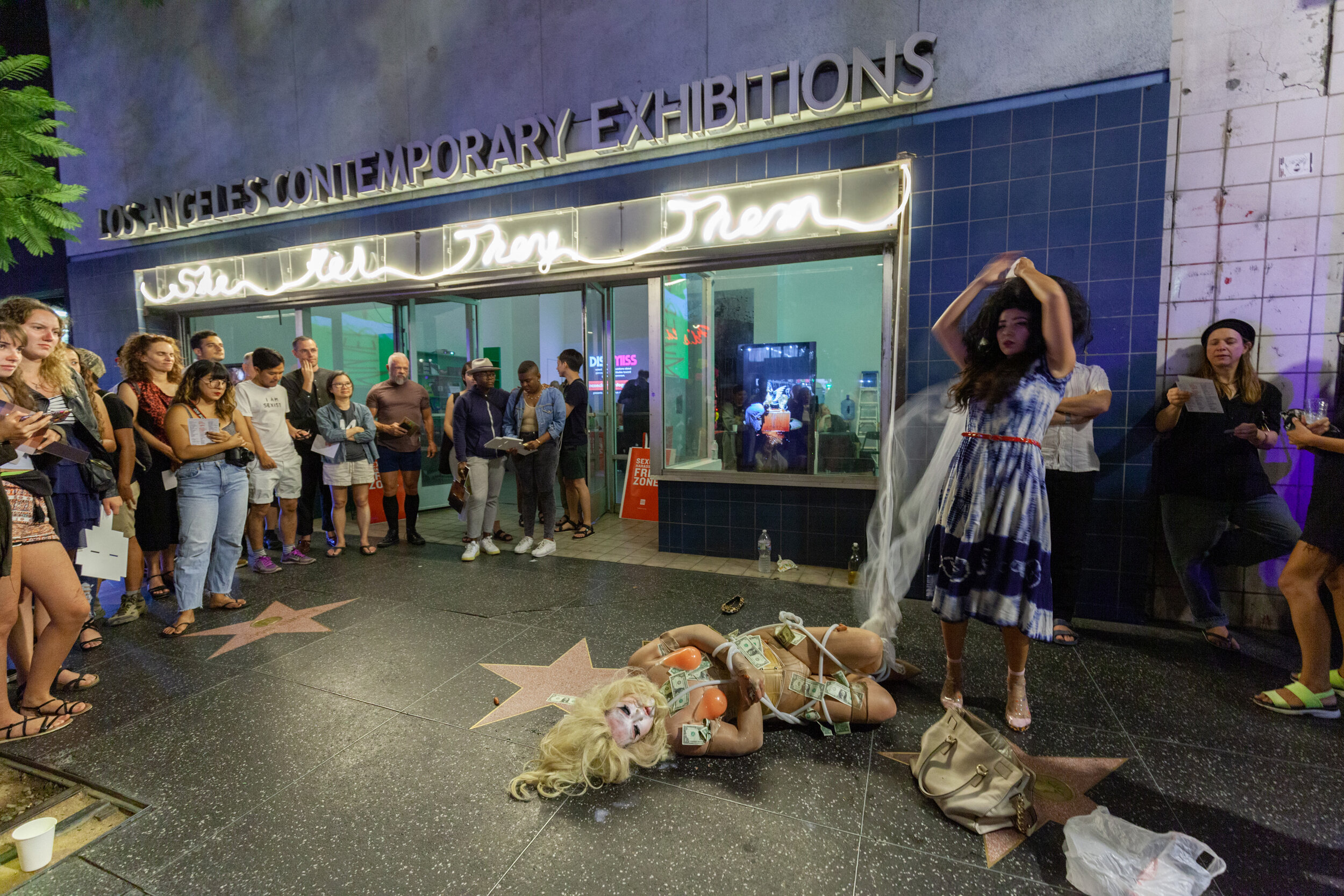Rites of Matrilineal Dissent
Rites of Matrilineal Dissent (2016 – ongoing) is a collaborative project between artists Young Joon Kwak and Kim Ye, which comprises live performances, videos, and art installations. This project grew out of an exchange initiated by Ye—an artwork of Kwak’s in exchange for an act of “fantasy fulfillment” by Ye. Kwak asked Ye to lead them through the trials of becoming a “real woman.” This played out in a live performance at the Hammer Museum in 2016, in which Ye played the mother figure and Kwak played the role of Baby Girl. They continued to develop these roles in performances that weaved in and out of the institutions, exterior and interior spaces, and different social realms, using experimental forms of social engagement and audience participation. They have performed and exhibited this project at institutions and galleries including Kelly Strayhorn Theater (2022), CCA Wattis Institute (2019), Human Resources (2019), Los Angeles Contemporary Exhibitions (LACE) (2019), Walter Phillips Gallery, Banff, Canada (2018), Los Angeles Municipal Gallery (2017), and the Hammer Museum (2016).
Where I Am My Own Other, Where My Mother Is Me, 2016
Performance at the Hammer Museum, Los Angeles, CA
Where I Am My Own Other, Where My Mother Is Me, 2017
Video, 15 minutes, 3 seconds
Mommy And Baby Girl Go To An Art Show, 2017
Performance at the Los Angeles Municipal Art Gallery, Los Angeles, CA
Maternal River of No Return, 2018
3-channel film installation (variable loop), Walter Phillips Gallery, Banff, Alberta, Canada
Motherhood, 2019
Performance at the Wattis Institute, San Francisco, CA
Bondage of Pronouns, 2019
Performance at Los Angeles Contemporary Exhibitions, Los Angeles, CA
Young Joon Kwak + Kim Ye
Where I Am My Own Other, Where My Mother Is Me
by David Evans Frantz
A collaboration between artists Young Joon Kwak and Kim Ye, the video Where I Am My Own Other, Where My Mother Is Me(2017) complicates the tension between the psychological interior and exterior, performative action and documentation, fantasy and trauma, and the narrativization of gender transition. The video oscillates between footage of a performance the duo presented late last year and lushly seductive, dream-like breaks that recreate the actions performed in the prior presentation.
In the performance Kim, whose history as a professional dominatrix involves fulfilling individual fantasies through role-play scenarios, embodied a Mommy to Young, who took on the persona of her young daughter, through much of the performance embodying an infant (I will call her Baby). Part of a performance festival organized by Young’s collaborative project Mutant Salon at the Hammer Museum, in the performance Mommy berates, torments, pokes and prods, and humiliates Baby, what can be described as perhaps a hardcore Mommy Dearest-style tough love. Mommy teaches Baby to wear makeup; Baby wears high heels; Mommy instructs Baby on how to use sanitary pads; Mommy forces Baby to serve and eat cake (chastising her for eating too much and becoming fat); Mommy instructs Baby on how to work a pole and wave like a pageant queen. Tapping into the clichéd and damaging conceptions of femininity and womanhood, the give and take between Mommy and Baby’s dom/sub positionality, the hallmarks of role-play, complicate distinctions between trauma and fantasy, and gender roles and expectations.
Over the two hour duration of the performance, Mommy leads Baby through various spaces of the museum while interacting with visitors, beginning in the darkened space of Mutant Salon’s dizzying installation but progressing onto the courtyard stage, down through the Museum’s corporate marble lobby, and eventually out onto the sidewalk in Westwood along Wilshire Boulevard. The documentation of the performance is at times rough as the cameraperson negotiates the spaces of action, spectators, and the move from location to location, registering the progressive transition from interior space to an increasingly harsh light of the street. At the video’s conclusion, Baby is covered in makeup and cake waving at cars as they pass by and spectators pass in and out of the camera’s frame.
Responding to the original performance, Kwak and Ye’s video weaves the original footage with vignettes shot in the studio reenacting scenarios of the prior iteration often as close-up presenting the body in fragmented parts. These sequences are dreamy, seductive, and sensual—a kaleidoscope presentation of messy corporeality and plasticized materiality in stunning fluorescents (characteristic of other projects by Young). These perhaps introspective scenes might be best characterized as a visualization of Baby’s sub-space, the internalized psychological otherwhere of the submissive partner in a dom/sub role-play. Where the documentary footage is palpably past (this already occurred), the added sequences are notably of another temporality, perhaps not future but certainly somewhere other, possibly of undetermined interiority. At times, audio-recordings from the prior performance are presented over the newly shot sequences, a disjunctive meeting that upends the apprehension of linear time. These sequences are at times slow and glutinous, while at other moments are fast and frenetic, and often focus fetishistically on a particular object from the prior performance: heels, cake, handcuffs. While these segments reiterate the mother-daughter relationship previously established, the tone is subtly different. In one instance, slow pans over Ye’s face showing her wincing are intercut with her harshly reprimanding Baby who is handcuffed to a street light pole, pointing to the oscillation of multiple affects between mother and daughter engendered by the performance and video.
Through its layering of different audio and visual recordings, Where I Am My Own Other, Where My Mother Is Me blurs distinctions between the event, its documentation, and its reception both by the viewer and within the participant. In its reiteration of a mother-daughter script through the lens of sub/dom role-play, the performance also proposes alternate genealogies for genderfuckery and transness within a queer and feminist lens. As Kwak explained, the intention of the performance was to be a two-hour initiation by Ye into the process (including the perils and possibilities) of becoming a woman. As LGBT identity categories have become increasingly fixed and part of an increasing liberal order of commodity capitalism, Kwak and Ye’s collaboration ruminates on the messy relations between gender performance and temporality of performance through documentation.
Live Performance at the Hammer Museum, on October 30, 2016
WHERE I AM MY OWN OTHER, WHERE MY MOTHER IS ME, 2017
HD video, sound, 15 minutes 3 seconds
Videography: Abigail Collins, Jacinto Astiazarán
Sound: Jeepneys & Whiteboy Scream, Corazon del Sol & Barbara T. Smith, Marvin Astorga
[Dog Rock] Sculpture: Corazon del Sol
Contains footage from Mutant Salon’s Festival De Las Muertas, 2016
The video mixes documentation footage from the public performance by Young Joon Kwak and Kim Ye, along with additional scenes shot by the duo that highlight and reimagine aspects of a transitioning body through a different time and space, in order to question commonly held beliefs on the rites of womanhood and the possibilities for documenting this process. The piece restructures the dynamics of mother-daughter, public-private, real-imaginary, domination-submission, trauma-fantasy relationships in a way that expands the open-ended possibilities of our understanding of gendered identities and becoming bodies.
Mommy and Baby Girl go to an art show
live performance at the opening of “Ours is a City of Writers” at the LA Municipal Art Gallery, February 5, 2017
Organized by Suzanne Hudson, Simon Leung and James Nisbet
Maternal River Of No Return
Three-channel film installation (13:30 variable loop), commissioned by the Walter Phillips Gallery, Banff Centre, 2018.
Commissioned by Walter Phillips Gallery at the Banff Center, The Maternal River of No Return is a collaborative video work by Young Joon Kwak and Kim Ye that presents a fragmented storyline of a fictional family holiday. Drawing attention to the constructions of gender in an intentionally exaggerated performance of femininity, Ye plays a “mommy” figure to Kwak, the “baby,” and aims to mentor the youth in the difficult process of learning to “be a woman.” This performative reflection on the process of gender transition experienced by many individuals who identify as trans is interspersed with other vignettes. Taking inspiration from a selection of photographs of Marilyn Monroe shot while the celebrity was in Banff filming the 1954 film, River of No Return, the work satirizes idealized expressions of femininity connected with the townsite’s history. A nod to their own positions as Angelenos, who, like Monroe, experienced Banff as tourists, Kwak and Ye’s video, The Maternal River of No Return (2018), also critically reflects on the stereotypes and misrecognitions of identity in relation to touristic populations in the town of Banff.
Three-channel simulation (for preview)
Motherhood
Live performance at the Wattis Institute (2019)
The performance reprises Ye and Kwak’s roles as Mommy and Baby, enacting an initiation into a stereotypical womanhood and destructive femininity. Ye draws on her history as a professional dominatrix to embody an overbearing maternal figure to Kwak’s young daughter. She torments and humiliates Baby, while leading her through the galleries, interacting with the audience. The pair leave an abject, corporeal mess in their wake.
Bondage of Pronouns
Live performance at Los Angeles Contemporary Exhibitions (2019)
Performance Excerpt
All photos by Chia Lee


















